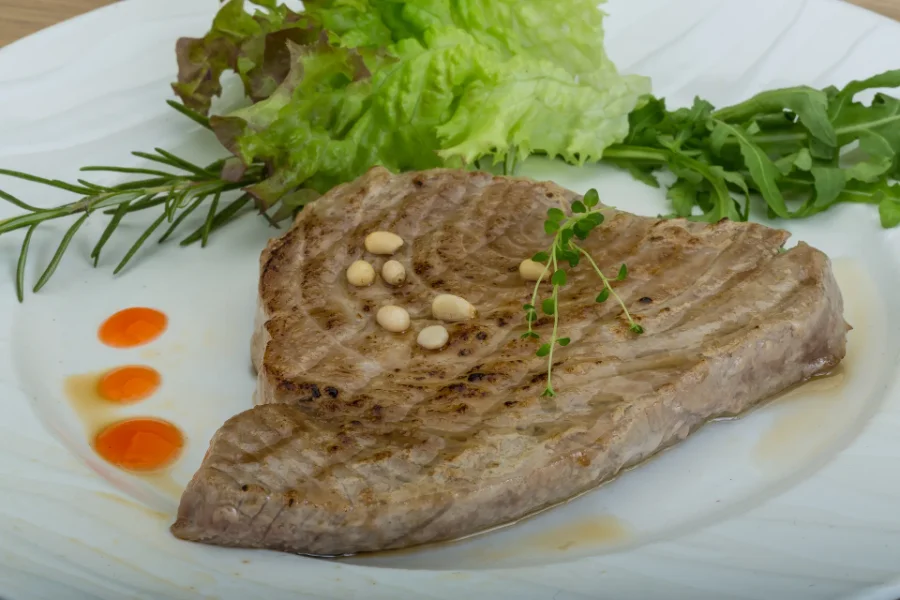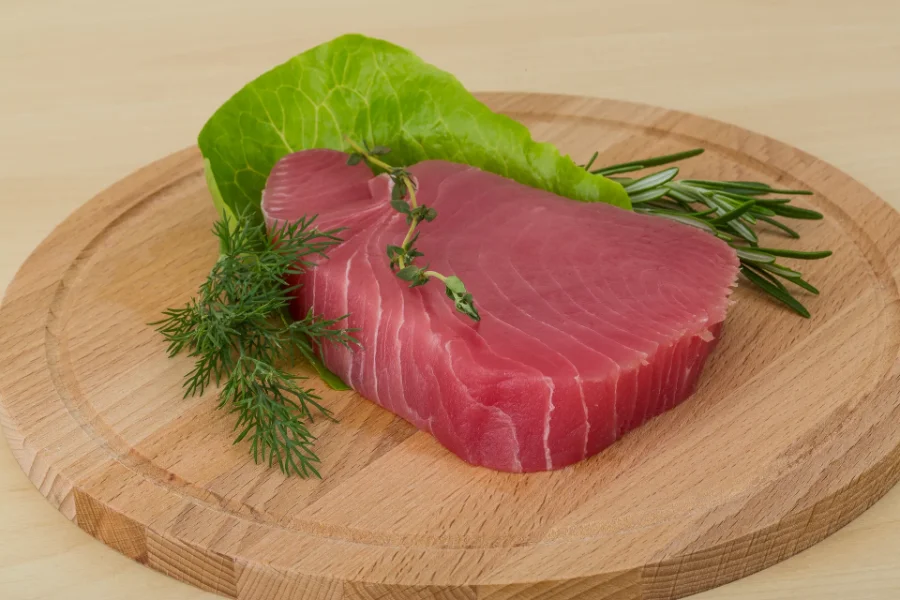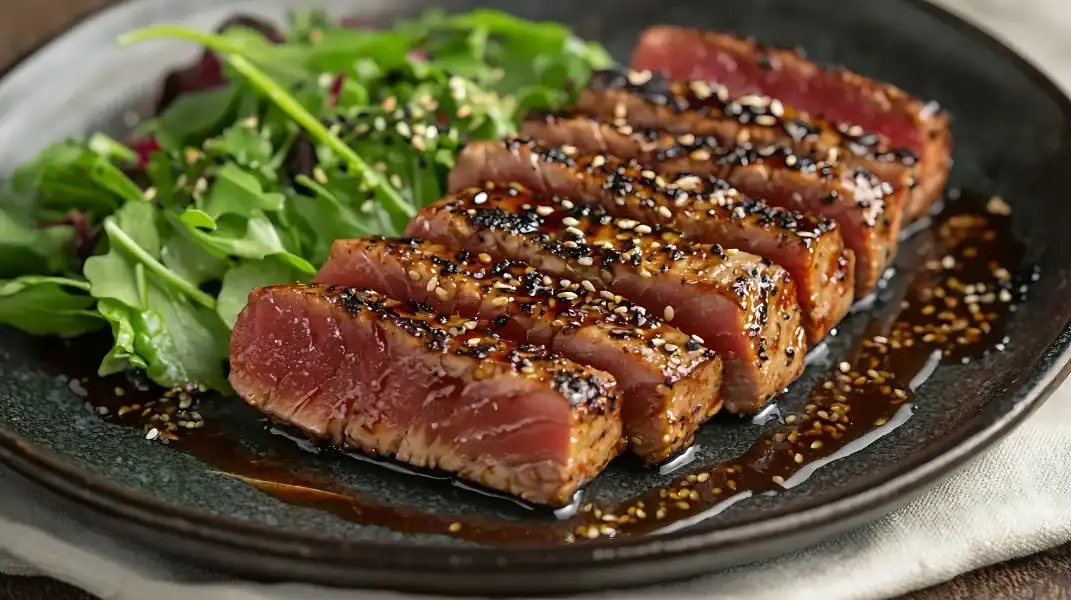Introduction
Tuna steaks are a top choice for seafood fans. They’re full of flavor, high in protein, and quick to cook. Whether you sear, grill, or bake them, they make a great meal. Still, many home cooks find it tricky to get the texture just right. In this post, we’ll cover Tuna Steaks: How to Make Them Tender and Delicious every time.
One common issue is overcooking. This turns your tuna dry and chewy. Others use the wrong cut or skip seasoning. These simple mistakes ruin the texture and taste.
The good news? You can easily fix that. In this post, you’ll learn how to choose, marinate, and cook tuna steaks the right way. We’ll cover searing, grilling, and baking methods. You’ll also get tips on seasoning and serving.
Whether you’re a beginner or just want better results, this guide is for you. You’ll discover the best way to make tuna steaks tender and delicious every time. Let’s dive in!
For more seafood recipes, try our:
- How to Make the Best Tuna Salad: A Classic Recipe You’ll Love
- Best Mussels Pasta Recipe: How to Cook Fresh Mussels for Pasta
- How to Cook Black Mussels: A Simple and Delicious Recipe
- How to Fry Squid Perfectly Every Time (Crispy and Tender!)
- How to Make Scallops Pasta Like a Pro – Simple & Delicious
Choosing the Right Tuna Steak
1. Ahi vs Yellowfin vs Bluefin – Understand the Key Differences
Not all tuna steaks are the same. Ahi and yellowfin are great for grilling or searing. They are lean, affordable, and widely available. Bluefin tuna is richer and more expensive. It’s often served rare or raw because of its buttery texture. Choose the type that fits your taste and budget.
2. Fresh or Frozen Tuna? – What to Look for When Buying
Both can work well. Fresh tuna should look moist and firm. It should not smell fishy. If buying frozen, make sure it’s vacuum-sealed and labeled “sushi-grade” or “sashimi-grade.” Avoid freezer-burned pieces or dull-looking flesh.
3. Best Cuts for Tender Results – Center-Cut, Sashimi-Grade, Thickness Matters
Go for center-cut steaks that are at least 1-inch thick. Thin steaks overcook fast and lose tenderness. Sashimi-grade tuna guarantees quality and is perfect for quick searing. Thick, uniform cuts cook evenly and stay juicy inside.
For more reading about tuna cuts, click here!
4. Where to Buy Quality Tuna Steaks – Butcher, Fishmonger, or Online Seafood Markets
Buy from trusted sources. Local fish markets and specialty butchers often carry fresh tuna. You can also order high-quality tuna steaks online. Look for sites that ship fresh or flash-frozen fish with clear quality labels.
5. Color, Smell, and Texture Tips – Spotting Freshness in Raw Tuna
Fresh tuna should have a deep red or pink color. It should feel firm, not mushy. Smell it—fresh tuna has a clean, ocean-like scent. If it smells off or looks gray, skip it.
Choosing the right tuna steak is the first step to a tender and delicious meal.
How to Marinate Tuna Steaks for Maximum Flavor

1. Simple Marinade Ideas – Soy Sauce, Garlic, Sesame Oil, and Lemon
A good marinade adds bold flavor to tuna steaks. Try mixing soy sauce, garlic, sesame oil, and fresh lemon juice. You can also add ginger or a touch of honey for extra depth. Keep it simple to let the tuna stand out.
2. Timing Matters – How Long to Marinate (Hint: Not Too Long)
Don’t marinate tuna steaks for hours. 15 to 30 minutes is enough. Tuna soaks up flavor fast. If you leave it too long, the acid from lemon or vinegar can break down the meat and make it mushy.
3. Marinade vs Dry Rub – When to Use Each for Best Flavor
Use a marinade when you want a juicy, well-rounded flavor. Use a dry rub if you’re cooking with high heat like grilling or pan-searing. Dry rubs keep the outside crisp and add bold seasoning without extra liquid.
For more reading, click here!
4. Avoiding Overpowering Flavors – Let the Tuna Shine
Tuna has a clean, meaty taste. Don’t cover it up with too many strong ingredients. Skip heavy sauces or too much salt. Use light marinades or simple herbs that enhance rather than hide the natural flavor.
5. Storage Safety – Keep It Cool, and Don’t Reuse Marinade
Always marinate tuna in the fridge, not on the counter. Use a sealed glass or plastic container. Never reuse the marinade after raw fish touches it. If you want to use it as a sauce, boil it first to kill bacteria.
With the right marinade, your tuna steaks will be full of flavor and ready for perfect cooking.
Cooking Methods: Pan, Grill, Oven, and Air Fryer
1. Pan-Searing Tuna Steaks – Quick, High Heat, Cast Iron Tips
Pan-searing is one of the best ways to cook tuna steaks. Use a hot cast iron skillet with a bit of oil. Sear each side for 1–2 minutes. This locks in the juices and gives a crispy crust. Don’t move the steak around too much. Let it brown nicely.
2. Grilling for Char and Flavor – Oil the Grill and Don’t Overcook
Grilling adds a smoky flavor that pairs well with tuna. Preheat your grill and oil the grates. Place the tuna steak over high heat and cook for 1–2 minutes per side. Flip it once only. Keep the inside rare to medium for best texture.
3. Oven-Baked Tuna Steaks – Even Cooking and Herb Crusts
Baking tuna is simple and great for thicker cuts. Preheat the oven to 400°F. Add olive oil, lemon, and herbs like thyme or rosemary. Bake for 10–12 minutes. This method works well if you like your tuna fully cooked but still moist.
4. Air Fryer Tuna Steaks – Fast and Crispy with Minimal Oil
Air fryers cook tuna steaks quickly and with less oil. Set the temperature to 375°F and cook for 6–8 minutes. You’ll get a crispy edge with a soft center. This method is perfect for a quick and healthy dinner.
5. Internal Temperature Guide – Use a Thermometer (Rare: 115°F, Medium: 125°F)
Cooking time depends on thickness. Use a food thermometer to check doneness. For rare tuna, aim for 115°F. For medium, go up to 125°F. Don’t go beyond 130°F or it will turn dry and tough.
Choose the method that fits your taste and schedule. Each one helps you cook tuna steaks that are tender, juicy, and full of flavor.
Seasoning and Sides That Enhance Tuna Steaks
1. Best Seasonings – Salt, Pepper, Herbs, Sesame Seeds
Tuna steaks don’t need much to shine. A simple mix of salt and black pepper works great. Add fresh herbs like rosemary, thyme, or dill for extra aroma. Toasted sesame seeds add a nice crunch and nutty flavor. Keep it light to let the tuna flavor stand out.
2. Sauce Pairings – Wasabi Mayo, Soy-Ginger Glaze, Lemon Butter
A good sauce brings your tuna steaks to life. Try wasabi mayo for a spicy kick. A soy-ginger glaze adds a sweet and salty balance. Lemon butter sauce is rich and zesty—perfect for grilled or pan-seared tuna. Drizzle just enough to enhance, not cover.
3. Healthy Sides – Quinoa, Grilled Vegetables, Avocado Salad
Pair tuna steaks with clean and simple sides. Quinoa is light and protein-rich. Grilled vegetables add color and crunch. An avocado salad brings creamy texture and healthy fats. These options balance your plate and keep the focus on the tuna.
4. Carb Lovers’ Pairings – Rice Pilaf, Garlic Mashed Potatoes, Pasta
Need something heartier? Rice pilaf soaks up sauces well. Garlic mashed potatoes are creamy and comforting. Light pasta dishes with olive oil or lemon also match tuna beautifully. Choose what suits your mood and mealtime.
5. Wine and Drink Suggestions – Sauvignon Blanc, Citrus Cocktails, Iced Tea
Round out your tuna steak meal with the right drink. Sauvignon Blanc is crisp and refreshing. Citrus cocktails pair well with lemony marinades. For a non-alcoholic option, try iced tea with a splash of lemon. It keeps the flavors fresh and balanced.
With the right seasonings, sides, and drinks, your tuna steaks will taste even better.
Expert Tips to Avoid Overcooked Tuna

1. Watch the Time – Tuna Cooks Fast (1–2 Minutes Per Side)
Tuna steaks cook quickly. One to two minutes per side is usually enough. Keep your heat high and stay close. Overcooking even by a minute can dry it out. Always time it right.
2. Thicker Steaks, Better Control – Avoid Thin, Quick-Drying Cuts
Choose tuna steaks that are at least 1 inch thick. Thicker cuts hold moisture better and give you more control. Thin pieces cook too fast and often turn chewy.
3. Rest Before Cutting – Let Juices Settle Inside
Let your tuna steak rest for a few minutes after cooking. This helps the juices stay inside. If you cut it too early, the steak may lose moisture and flavor.
4. Sear Outside, Keep Center Rare – The Golden Tuna Rule
Aim for a seared outside and a rare to medium-rare center. This method keeps the tuna tender and rich. Use high heat for a quick crust, then take it off the pan.
5. Avoid Reheating Tuna – Enjoy Fresh or Eat Leftovers Cold
Tuna doesn’t reheat well. It dries out fast and loses flavor. Eat it fresh for the best taste. If you have leftovers, enjoy them cold in salads or wraps.
Follow these expert tips to avoid overcooked tuna and enjoy juicy, tender steaks every time.
Sesame-Crusted Seared Tuna Steak with Greens

Sesame-Crusted Seared Tuna Steak with Greens
Ingredients
Method
- Marinate the Tuna: In a bowl, mix soy sauce, sesame oil, rice vinegar, ginger, and garlic.
- Place tuna steaks in the marinade and coat well. Let sit for 15–20 minutes.
- Prep the Salad: Toss salad greens with olive oil, lemon juice, salt, and pepper. Set aside.
- Coat with Sesame Seeds: Remove tuna from the marinade. Pat dry slightly. Press sesame seeds onto both sides of each steak.
- Sear the Tuna: Heat olive oil in a pan over high heat.
- Sear tuna steaks for about 1–2 minutes per side (outside should be golden, inside still pink).
- Serve: Slice tuna and plate over the salad greens. Drizzle with any remaining marinade (boil it first if using).
FAQs About Cooking Tuna Steaks
1. What’s the best way to cook tuna steaks?
Pan-searing is the most popular. It gives a crisp crust while keeping the center tender and juicy. Grilling and baking are also great methods.
2. How long should I cook tuna steaks?
Tuna cooks quickly—just 1 to 2 minutes per side for medium-rare. Thicker cuts may need slightly more time.
3. Should tuna steaks be raw in the middle?
Yes, it’s common to serve them seared on the outside and rare or medium-rare inside. This keeps them tender and flavorful.
4. What’s the ideal internal temperature for tuna steaks?
For rare: 115°F (46°C). For medium: 125°F (52°C). Avoid cooking past 130°F to prevent dryness.
5. Can I marinate tuna steaks overnight?
No, it’s better to marinate for 15–30 minutes. Longer times can break down the meat and affect the texture.
Conclusion
Cooking tuna steaks doesn’t have to be hard. Start with high-quality tuna. Use a simple marinade with fresh ingredients. Cook it fast using the right method—pan, grill, oven, or air fryer.
Try different seasonings and sauces to match your taste. Add healthy or hearty sides to complete the meal. There’s no one right way—just find what works for you.
Now that you know how to make tuna steaks tender and delicious, it’s your turn. Try this recipe and let us know your favorite way to cook tuna steaks. Drop a comment or share your tips—we’d love to hear from you!
For more recipes, try our:


2 thoughts on “Tuna Steaks 101: How to Make Them Tender and Delicious Every Time”